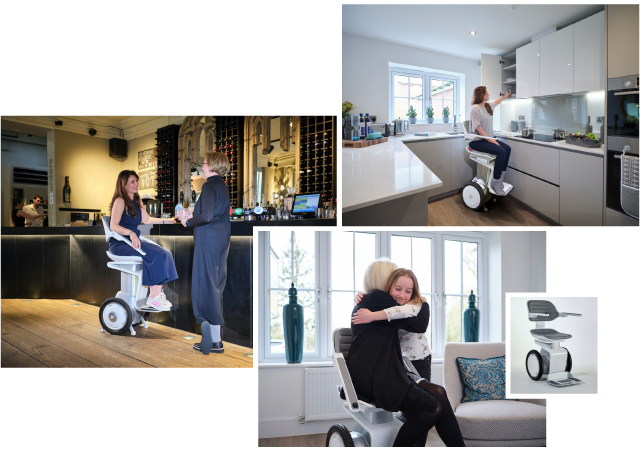Mobility matchmaking – Part 2: The Centaur

Mobility matchmaking – Part 2: The Centaur
Which 2023 wheelchair or mobility scooter would you choose to chum up with?
The design choice in wheelchairs and mobility scooters is growing globally [1], which is excellent news for users and those who support them.
But what should you be looking for in your new mobile buddy who may be accompanying you for years to come?
Our neuro OTs are experts at sourcing the right mobility aids for their clients. So, to help kick-start your search, we’re taking an impartial* look at 10 of the latest models turning heads in the UK this year.
And in Part 2 of our series, it’s the 2022/23 winner of a UK accessibility award for innovative design that is at the centre of our attention...
The Centaur
 The wheelchair hasn’t been updated since it was modernised in the 1950s, and the design has seen little improvement. We knew this needed to change.
The wheelchair hasn’t been updated since it was modernised in the 1950s, and the design has seen little improvement. We knew this needed to change. 
Design Director Paul Campbell [2]
When you can empower a Paralympian with your wheelchair prototype, it’s no wonder it’s a winner in the judges’ eyes at the UK’s Blue Badge Access Awards.
The self-balancing, two-wheeled Centaur – named after the mythical Greek half-horse, half-human being – galloped off with the Guest Innovation Prize at the 2022/23 event.
The awards set the gold standard for disability access in the hospitality, tourism and leisure sectors.
But it was the pursuit by a father of a better standard of life for his child that inspired the Centaur’s conception. Centaur Robotics co-founder David Rajan’s son had cerebral palsy.
David felt that standard wheelchair designs could be improved. “He wanted something his son could be proud of, that was human-centred and allowed him to get on with his life,” a company spokesperson explains.
To achieve his goal, he teamed up with former chief designer for Ford Motor Co, Paul Campbell, whose father also had struggled using traditional wheelchairs...as Paul describes here:
 It was bad enough that it didn’t fit under a dining table, but there were always grazed knuckles from narrow doorways and spilt food from being too far away from the table.
It was bad enough that it didn’t fit under a dining table, but there were always grazed knuckles from narrow doorways and spilt food from being too far away from the table. 
Paul’s former Ford colleague, chief engineer John Reed also joined them, motivated by his disabled son, Matt and other disabled youngsters with whom he worked.
So, the Centaur was born – and soon afterwards, mobility campaigner Paralympian Baroness Tanni Grey-Thompson proudly became one of the company’s ambassadors.
Summing up her experience of the wheeled wonder, she said, “The Centaur gives you the freedom to do what you want when you want. It’s empowering.”
We found out more about what makes the Centaur stand out in a Q&A with its makers…
What makes the Centaur unique?
The Centaur is designed so that people see the person first before the vehicle. It’s scaled to fit at a dining table and elevate to eye level for conversations with friends and family.
The design allows it to manoeuvre around the home. There’s no need to significantly adapt your home as it easily turns in its own footprint and negotiates narrow doorways.
It is a self-balancing, two-wheeled vehicle, easy to operate via a joystick on the armrest. The Centaur is something people can take pride in.
Which wheelchair users do you think could best benefit?
The Centaur is designed for people in the early stages of mobility impairment. It is an attractive alternative for those using a wheelchair who have some core strength.
Amputees, injured military veterans, and people with early-stage degenerative conditions […] add up to about 120,000 potential customers from this group in the UK.
However, the size and value of the Centaur’s market is also driven by the growing number of older people in the developed world. About one-third of this group in the UK have a mobility-related disability. That’s about 3.5 million people.
How easy is it to operate?
The Centaur is designed to be intuitive, therefore, simple to operate. You use a joystick on the armrest and do not have to move your body to propel it forward or backwards.
The driver has ultimate control, so needs to be aware of their immediate environment, other people around them, and the limitations of the machine.
For example, like most power chairs, it cannot be driven off a 100mm kerb, although it will negotiate ramps and slopes on pavements designed for wheelchairs.
A floor-level footplate provides a stable platform for easy access. It lifts when the Centaur is underway.
Are there any environments that may pose challenges to using it?
The Centaur has not been tested on off-road surfaces such as sand, gravel and grass but easily negotiates pavements, tarmac, and carpeted, polished and tiled floors.
In which areas of daily life would the Centaur prove most beneficial?
The Centaur is perfect for getting around at home or in a retirement village, reaching high places in the kitchen and sitting at a dining table at a restaurant.
It is designed to help people age in place for longer, stay independent, and travel short distances from their homes, for example, to nearby shops and cafes.
The Centaur is designed to look good to allow users to be proud of their vehicle. We want people to see the user, not the chair.
With the Centaur, you could order at the bar, be at eye-level with others and fit through narrow doorways and into the space of a dining room chair.
It is safe, simple to operate and fun to ride despite its serious credentials.
You say on your website the Centaur is for people who are “more adventurous” as they age. In what ways?
People can stay active and independent longer and engage more with friends and family. Users can stand out for the right reasons, and socialise without being stigmatised, despite their limited mobility.
The Centaur will help people enjoy cruise ships and shopping trips or museums. And we are in talks with airports and airlines to reimagine the airport experience for at least 10% of the global population with restricted mobility who are dissatisfied with the service provided.”

Centaur and you?
To help you decide if the Centaur is for you, check out its manufacturer’s faqs page here: [3] It includes the following facts and stats:
- Centaur width: 535mm
- Seat height: from 465mm to 765mm
- Weight: about 70kgs
- Classified as a Class 2 invalid carriage
- For use indoors and outdoors, including on pavements and ramps
- Cannot be used on roads
- Travels up to 4mph
- Recommended for weights up to 120kgs
Prototypes of the Centaur will be in the hands of consumer testers later this year. Its market debut is set for June 2024.
Make it a match
To help you find your ideal match in the shape of a wheelchair or mobility scooter, it helps to ask the following questions:
- How much time will you spend on it?
- Which activities do you need it for and where?
- Does it give you the space, support, and comfort you need?
- Will you need any unique accessories or an extra safety kit?
- How will you store and transport it?
- Have you any physical or cognitive challenges that would limit your use of it?
- What is your budget?
* Opinions and endorsements published by others on Krysalis Consultancy Ltd blogs or publications do not necessarily reflect the views of Krysalis Consultancy Ltd.
Further reading
“We have found that Omeo’s intuitive features make it almost become an extension of the user’s body, allowing us to feel more human...”
Meet Dragon’s Den darling, the off-roading Omeo and more tips on finding the suitable wheelchair or mobility scooter in our Mobility Matchmaking series launch here: Mobility matchmaking
Recently on talkingheads...
References
1. Mobility Aid Devices Market research Report with Analysis 2023 To 2030 - MarketWatch









